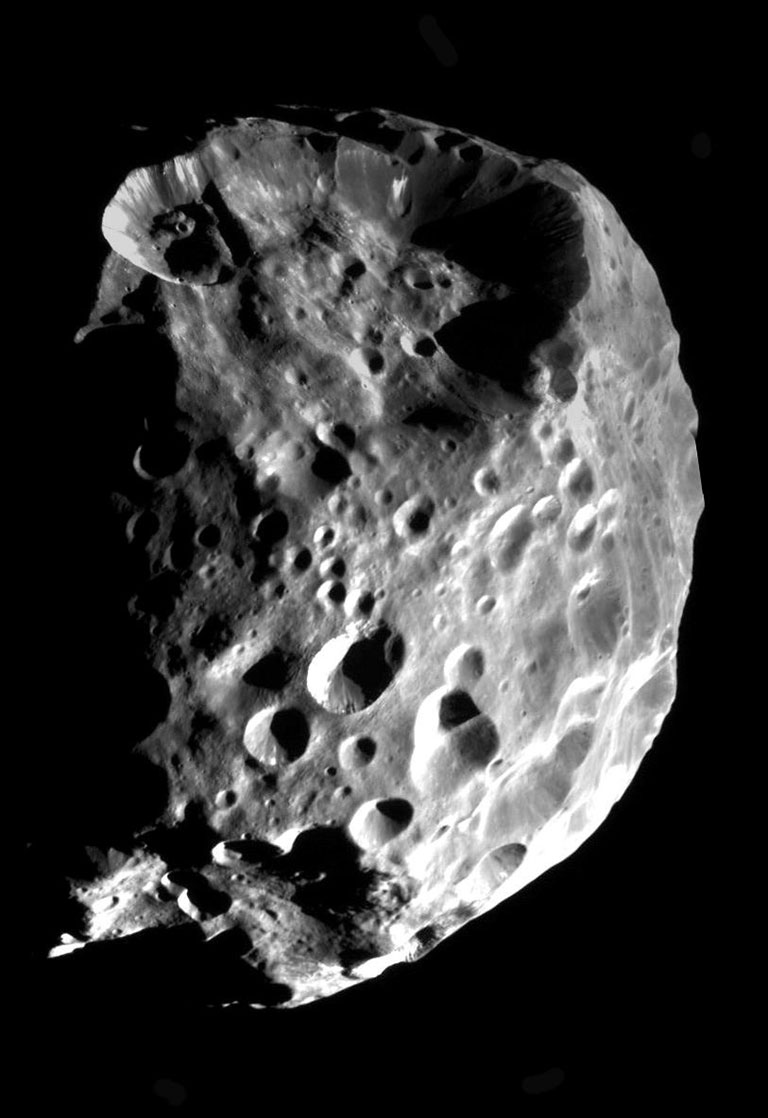Phoebe

Phoebe was discovered August 1898 by American astronomer William Pickering.
Phoebe was the first target encountered upon the arrival of the Cassini spacecraft in the Saturn system in 2004, and is thus unusually well-studied for an irregular moon of its size. Cassini's trajectory to Saturn and time of arrival were specifically chosen to permit this flyby.
Phoebe is one of Saturn's most intriguing moons, orbiting at a distance of 8,049,668 miles (12,952,000 kilometers) from the planet, almost four times the distance from Saturn than its nearest neighbor, the moon Iapetus. Phoebe and Iapetus are the only major moons in the Saturnian system that do not orbit closely to the plane of Saturn's equator.
Phoebe is roughly spherical and has a mean radius of about 66.2 miles (106.5 kilometers), about one-sixteenth the radius of Earth's Moon. Phoebe rotates on its axis every nine hours, and it completes a full orbit around Saturn in about 18 Earth months. Its irregular, elliptical orbit is inclined about 175 degrees to Saturn's equator. Phoebe's orbit is also retrograde, which means it goes around Saturn in the opposite direction than most other moons — as well as most objects in the solar system.
Unlike most major moons orbiting Saturn, Phoebe is very dark and reflects only 6 percent of the sunlight it receives. Its darkness and irregular, retrograde orbit suggest Phoebe is most likely a captured object. A captured object is a celestial body that is trapped by the gravitational pull of a much bigger body, generally a planet. Phoebe's darkness, in particular, suggests that the small moon comes from the outer solar system, an area where there is plenty of dark material.
Some scientists think Phoebe could be a captured Centaur. Centaurs are believed to be Kuiper Belt bodies that migrated into the inner solar system. Centaurs are found between the asteroid belt and the Kuiper Belt, and are considered a kind of intermediate type of small body, neither an asteroid nor a Kuiper Belt object. If Phoebe is indeed a captured Centaur, images and scientific data of Phoebe taken by the Cassini spacecraft will give scientists the first opportunity to study a Centaur.
Centaurs are of extreme interest to scientists because they are believed to be primordial; that is, they appear to date from the formation of the solar system. These objects are the building blocks of the solar system, the leftovers that never pulled into a planet. And because of its relative small size, Phoebe might never have heated up enough to change its chemical composition — which increases the scientific value of its study.
Moons of Saturn were originally named for Greco-Roman Titans and descendants of the Titans. But as many new moons were discovered scientists began selecting names from more mythologies, including Gallic, Inuit and Norse stories.
Phoebe is another name for the goddess that the Greeks called Artemis and the Romans called Diana. She was the youthful goddess of Earth's Moon, forests, wild animals, and hunting. Sworn to chastity and independence, she never married and was closely identified with her brother Apollo.




